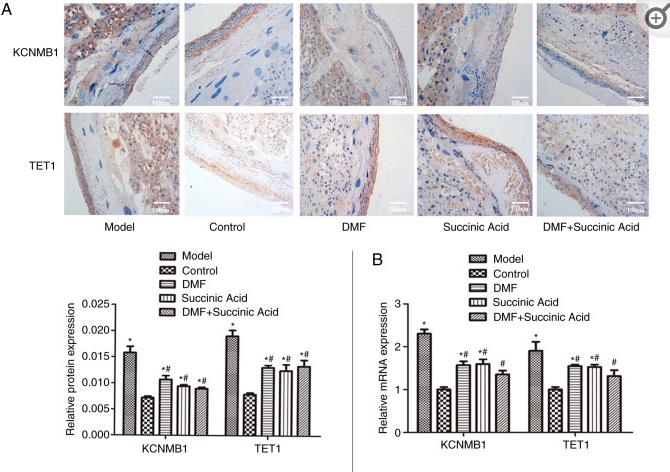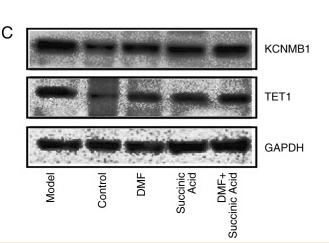KCNMB1 Antibody - #DF9301
| Product: | KCNMB1 Antibody |
| Catalog: | DF9301 |
| Description: | Rabbit polyclonal antibody to KCNMB1 |
| Application: | WB IHC IF/ICC |
| Cited expt.: | WB, IHC |
| Reactivity: | Human, Mouse, Rat, Monkey |
| Prediction: | Bovine, Horse, Sheep, Rabbit, Dog |
| Mol.Wt.: | 22 kDa; 22kD(Calculated). |
| Uniprot: | Q16558 |
| RRID: | AB_2842497 |
Related Downloads
Protocols
Product Info
*The optimal dilutions should be determined by the end user. For optimal experimental results, antibody reuse is not recommended.
*Tips:
WB: For western blot detection of denatured protein samples. IHC: For immunohistochemical detection of paraffin sections (IHC-p) or frozen sections (IHC-f) of tissue samples. IF/ICC: For immunofluorescence detection of cell samples. ELISA(peptide): For ELISA detection of antigenic peptide.
Cite Format: Affinity Biosciences Cat# DF9301, RRID:AB_2842497.
Fold/Unfold
BK channel beta subunit; BK channel subunit beta 1; BKbeta; BKbeta1; Calcium activated potassium channel subfamily M subunit beta 1; Calcium activated potassium channel subunit beta 1; Calcium activated potassium channel subunit beta; Charybdotoxin receptor subunit beta 1; Hbeta1; hslo beta; K(VCA)beta 1; K(VCA)beta; KCNMB 1; KCNMB1; Large conductance Ca2+ activated K+ channel beta 1 subunit; Maxi K channel beta subunit; Maxi K channel subunit beta 1; Potassium large conductance calcium activated channel subfamily M beta member 1; Slo beta 1; SLO beta;
Immunogens
A synthesized peptide derived from human KCNMB1, corresponding to a region within the internal amino acids.
Abundantly expressed in smooth muscle. Low levels of expression in most other tissues. Within the brain, relatively high levels found in hippocampus and corpus callosum.
- Q16558 KCMB1_HUMAN:
- Protein BLAST With
- NCBI/
- ExPASy/
- Uniprot
MVKKLVMAQKRGETRALCLGVTMVVCAVITYYILVTTVLPLYQKSVWTQESKCHLIETNIRDQEELKGKKVPQYPCLWVNVSAAGRWAVLYHTEDTRDQNQQCSYIPGSVDNYQTARADVEKVRAKFQEQQVFYCFSAPRGNETSVLFQRLYGPQALLFSLFWPTFLLTGGLLIIAMVKSNQYLSILAAQK
Predictions
Score>80(red) has high confidence and is suggested to be used for WB detection. *The prediction model is mainly based on the alignment of immunogen sequences, the results are for reference only, not as the basis of quality assurance.
High(score>80) Medium(80>score>50) Low(score<50) No confidence
Research Backgrounds
Regulatory subunit of the calcium activated potassium KCNMA1 (maxiK) channel. Modulates the calcium sensitivity and gating kinetics of KCNMA1, thereby contributing to KCNMA1 channel diversity. Increases the apparent Ca(2+)/voltage sensitivity of the KCNMA1 channel. It also modifies KCNMA1 channel kinetics and alters its pharmacological properties. It slows down the activation and the deactivation kinetics of the channel. Acts as a negative regulator of smooth muscle contraction by enhancing the calcium sensitivity to KCNMA1. Its presence is also a requirement for internal binding of the KCNMA1 channel opener dehydrosoyasaponin I (DHS-1) triterpene glycoside and for external binding of the agonist hormone 17-beta-estradiol (E2). Increases the binding activity of charybdotoxin (CTX) toxin to KCNMA1 peptide blocker by increasing the CTX association rate and decreasing the dissociation rate.
N-glycosylated.
Membrane>Multi-pass membrane protein.
Abundantly expressed in smooth muscle. Low levels of expression in most other tissues. Within the brain, relatively high levels found in hippocampus and corpus callosum.
Belongs to the KCNMB (TC 8.A.14.1) family. KCNMB1 subfamily.
Research Fields
· Environmental Information Processing > Signal transduction > cGMP-PKG signaling pathway. (View pathway)
· Organismal Systems > Circulatory system > Vascular smooth muscle contraction. (View pathway)
· Organismal Systems > Endocrine system > Insulin secretion. (View pathway)
References
Application: IHC Species: Rat Sample: placental cells
Application: WB Species: Rat Sample: placental cells
Restrictive clause
Affinity Biosciences tests all products strictly. Citations are provided as a resource for additional applications that have not been validated by Affinity Biosciences. Please choose the appropriate format for each application and consult Materials and Methods sections for additional details about the use of any product in these publications.
For Research Use Only.
Not for use in diagnostic or therapeutic procedures. Not for resale. Not for distribution without written consent. Affinity Biosciences will not be held responsible for patent infringement or other violations that may occur with the use of our products. Affinity Biosciences, Affinity Biosciences Logo and all other trademarks are the property of Affinity Biosciences LTD.



